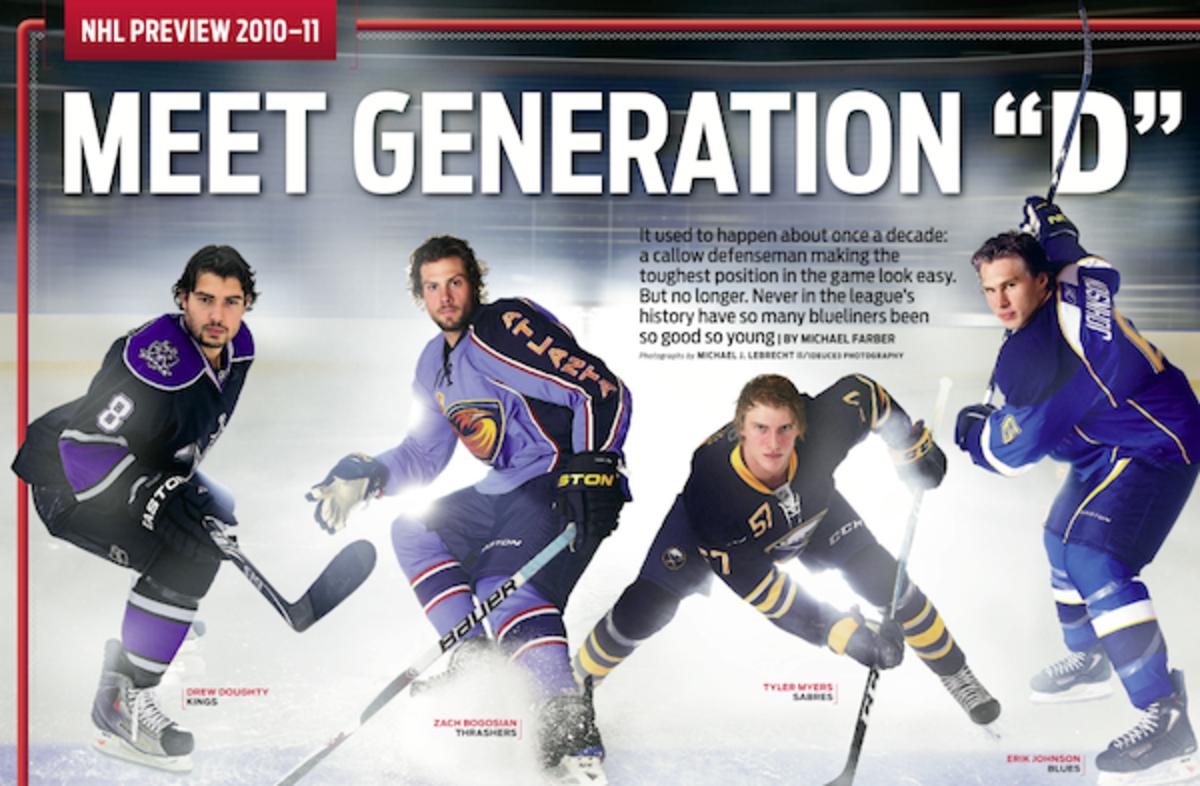Eye Test: Who's better—Tyler Myers or Zach Bogosian?

The long-awaited Evander Kane trade finally happened, and now we know why it took so long: The Jets needed to make sure it was as complex and vexing as possible. Most problematic to our ability to declare a winner is the trade-within-the-trade that sent defenseman Zach Bogosian to the Sabres in exchange for blueliner Tyler Myers. Not only are opinions split on which defenseman is better, no one can even decide which one of them had more trade value, and, in turn, which team made a concession in agreeing to the swap.
Sabres trade for Evander Kane in a high risk, high reward deal for all
Bogosian and Myers were both first-round picks in the 2008 draft, and both have, to put it lightly, underachieved in the NHL. Central Scouting rated them as the fourth and fifth best North American skaters, respectively, in their draft class. They were supposed to become franchise defensemen in a draft that turned out to be full of them: Drew Doughty, Erik Karlsson, Alex Pietrangelo, John Carlson and Roman Josi all went in the first 40 picks.
Myers’ career arc could be described as a fall from grace after a rapid rise. He won the Calder Trophy in 2009–10, when he scored 48 points and was +13. But he has never come close to those numbers in any of the last five seasons (though to be fair, he has played more than 62 games in a season only once since then). Bogosian, by contrast, has a consistently unspectacular track record, never besting the 30 points he put up in ’11–12.
The fancystats for both players provide little clarity. Myers’ Fenwick For percentage (FF%) has taken a nosedive in the last three seasons—from 46.5% to 43.5% to 36.4%—but that trend corresponds to Buffalo’s general decline, as well as with Myers being asked to play in all situations as a big-minute defensive defenseman. Bogosian’s possession stats track more consistently—mostly hovering around 50%—but have, disconcertingly, always lagged behind the team’s number. Myers, for all his disappointments, at least came out positive in terms of FF% relative to his team in three of the five seasons since his breakout rookie campaign.
Players with reputations still clouded by pre-draft scouting hype and with statistics muddled by team quality are perfect candidates for the Eye Test, so for this one, I’m pitting Myers and Bogosian head-to-head to predict who will get the better of a classic change-of-scenery trade.
Tyler Myers is tall
I mean, he’s really tall — 6' 8" to be exact. And when a guy with that frame scores 48 points in his rookie season, fans slip into the homoerotic fantasies of what a “beast” the guy will be when he “fills out.” He’ll be Zdeno Chara meets Shea Weber meets Batman! It’ll be awesome!
Eye Test: Cody Franson's game is ugly, but his pretty stats don't lie
But not every tall defenseman becomes a punishing monster. Hal Gill, Marek Malik and, to use a more recent example, Cody Franson, all topped 6' 5" without ever acquiring a mean streak. Also, Gill and Malik did—and Franson does—skate about as slow as the trees that they tower over grow. Myers moves fast, sneakily fast even, and that speed is at the heart of his volatile young career.
For all his size and pedigree, Myers remains fundamentally a puck-moving offensive defenseman. In his rookie season, he fearlessly joined the rush on seemingly every other shift. And he wasn’t just moving the puck out of the defensive zone. He went from goal line to goal line regularly. He made slick stick handling moves. Above all, he exhibited supreme confidence.
Now Myers plays tentatively. The trick to being a defenseman is building a series of complex reflexes and learning to trust them. When young blueliners play a totally unthinking game before they’ve developed their reflexes, smarter forwards draw them out of position with clever passing and stick handling. Conversely, if a young defenseman has to actually sit there and think, “What comes next?” he will get caught flat-footed almost every time.
Maybe the way Myers played in his Calder-winning year was raw — a kind of instinctual, offense-obsessed mad dash. But the pendulum has swung too far in the other direction. He has what I’ll call Jack Johnson’s Disease, a need to do everything very deliberately, seemingly out of some fear of ending up on a blooper reel.
Check out Myers (57) on this harmless zone-exit play, which somehow blows up in his face. He sees one forechecker coming in wide-open ice and just falls to pieces:

The stutter step is most concerning. Compare it to a not wholly analogous, but still telling, zone exit from his breakout rookie year:

He calmly uses his reach to keep the puck from the onrushing forechecker, and then hands it off before joining the rush and skating ahead of the puck-carrier.
Sorry, I don't think Myers is the American answer to Chara. (Should Boston’s big man ever go rogue, the actual American answer to Chara would probably involve fighter jets attacking the head while tanks attempt to slow the feet.) But Myers can mitigate his defensive struggles by disrupting plays with his long limbs and stick. And his skating ability with and without the puck isn’t just good for his size, it’s excellent, full stop. The above play from 2010—in which he uses his reach to retrieve the puck, his size to shield it and his speed to start an odd-man rush—represents the best of Myers’ unique skill-set.
Zach Bogosian is not as tall
In contrast to Myers’ 2008 draft status as a tantalizing package of size and skill, Bogosian was a mostly finished product, at least physically. E.J. McGuire, the late, great director of Central Scouting, in his pre-draft report on Bogosian, seemingly preferred him to Myers, lauding Bogosian’s “fully proportioned” body compared with some unnamed taller defensemen who “have to grow into their [bodies].”
Sometimes, though, having no room to grow can mean just that: a ceiling. Hard-hitting, smooth-skating defensemen who lack a single superstar-quality tool can still be great Dan Hamhuis-types. But Bogosian is not quite Dan Hamhuis either ... and it’s borne out in the advanced stats.
Besides a birth year, here’s something else Bogosion and Myers have in common: an inability to think the game quickly enough in the defensive zone. This recent Bogosian (44) shift with Toby Enstrom(39) typifies, I think, the difference between a good, puck-moving No. 3 defenseman and Bogosian. He throws two needless body checks against players who no longer have the puck, as if the point of hockey is to amass hits, while Enstrom skates into position, forces an interception, and initiates a zone exit:

I’d like to put microchips in the skates of all the league’s second pairing defensemen to measure their acceleration. I’m guessing the players with the flattest graphs would also have the best possession stats. Perpetual acceleration machines like Enstrom and Hamhuis, who glide around, constantly tweaking their position, stay a step ahead of the play. Guys like Bogosian who are forever stopping and starting—chasing hits that leave them out of position—are too often caught flat-footed. Bogosian plays a simple, serviceable game, but he’s the fourth-best defenseman on a good team.
The Verdict
SPORTS ILLUSTRATED’s 2010–11 season preview declared both Myers and Bogosian, along with Doughty and Erik Johnson, “Generation D,” a group of young defensemen who were making the position look easy:

In the package, scouting reports from Hall of Famers at the position praised Doughty’s hockey sense, while focusing on the skating ability of the other three. Perhaps not coincidentally, the other three have now all been abandoned by the teams that drafted them. Maybe the scouting community’s belief that physical specimens can develop Hockey IQ after a few seasons is misplaced. Suffice to say, the intelligent but soft Euros in that draft, Josi and Karlsson, should have gone higher.
Myers’ skating ability and puck-handling moves, for me, resemble those of the Predators’ Seth Jones. But before I give in to the temptation to compare them as hockey players, I’m reminded of Bob McKenzie stressing the importance of hockey sense while downplaying comparisons between Jones and Erik Johnson at the 2013 draft: “The comparisons couldn’t be further from the truth,” McKenzie said. “Erik Johnson was a guy who, the year before his draft, wasn’t really much on the radar for anybody. He became a late-blooming man-child that everybody jumped on the bandwagon for.”
The Sabres and the Jets have now swapped man-children. And I can’t help but like the trade for Winnipeg. While Bogosian may be more physical and positionally sound, he doesn’t have much of an advantage over Myers given that he and Myers both anticipate plays in their own zone at the same speed. What’s Bogosian’s ceiling, realistically? Kevin Klein? Paul Martin? Given the choice between two athletic players with poor defensive awareness, I’ll take the more explosive skater every time.
